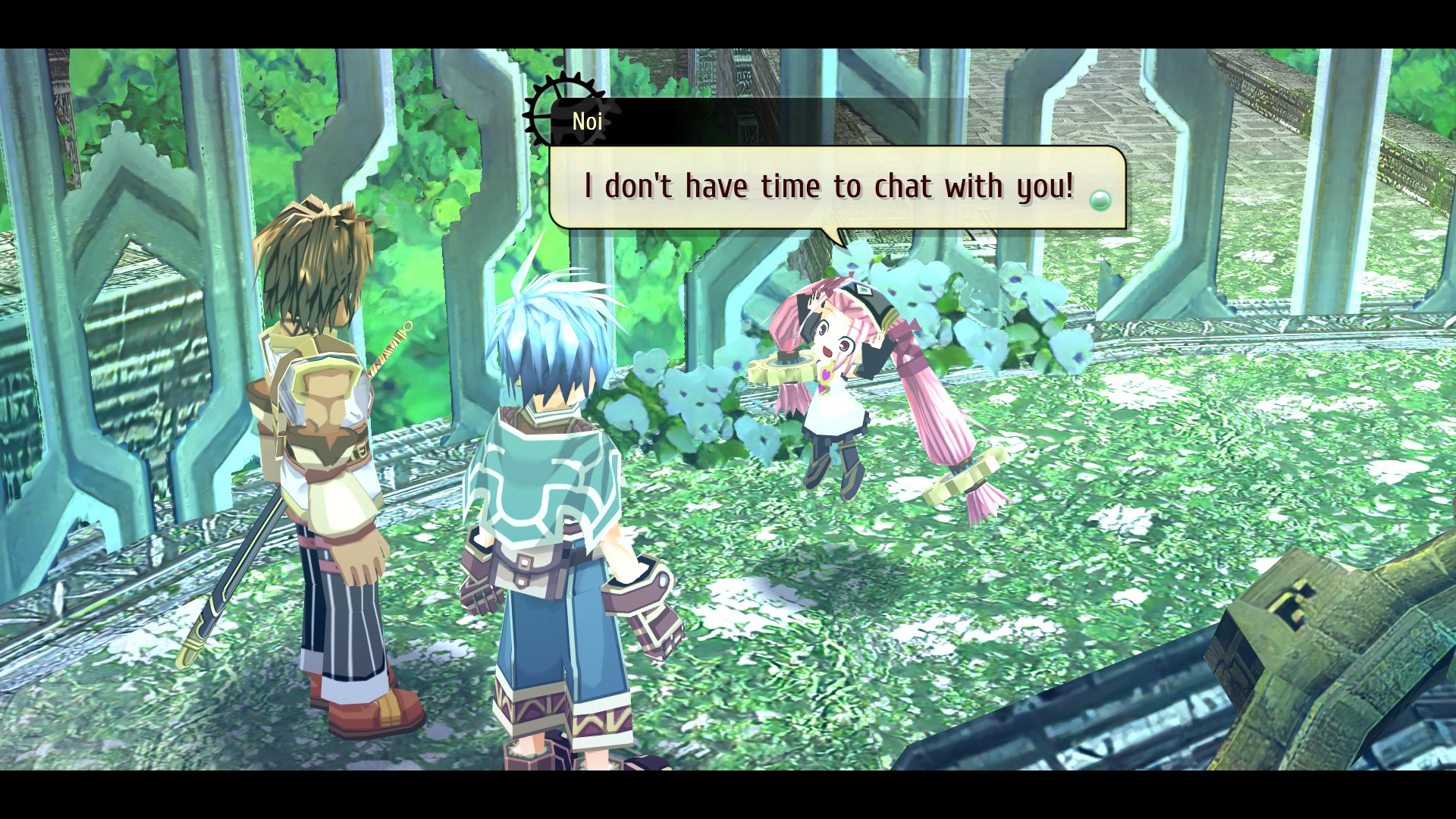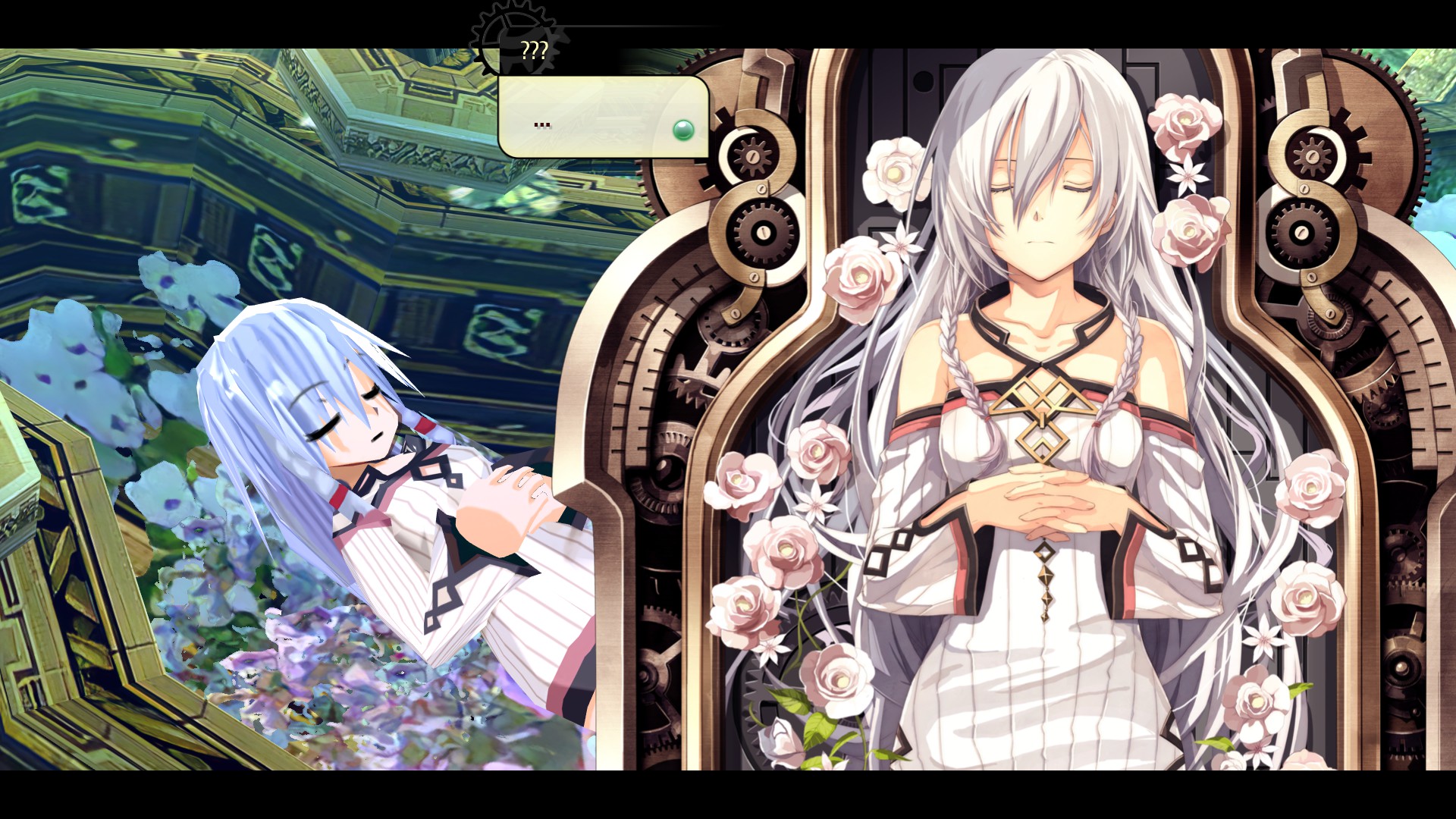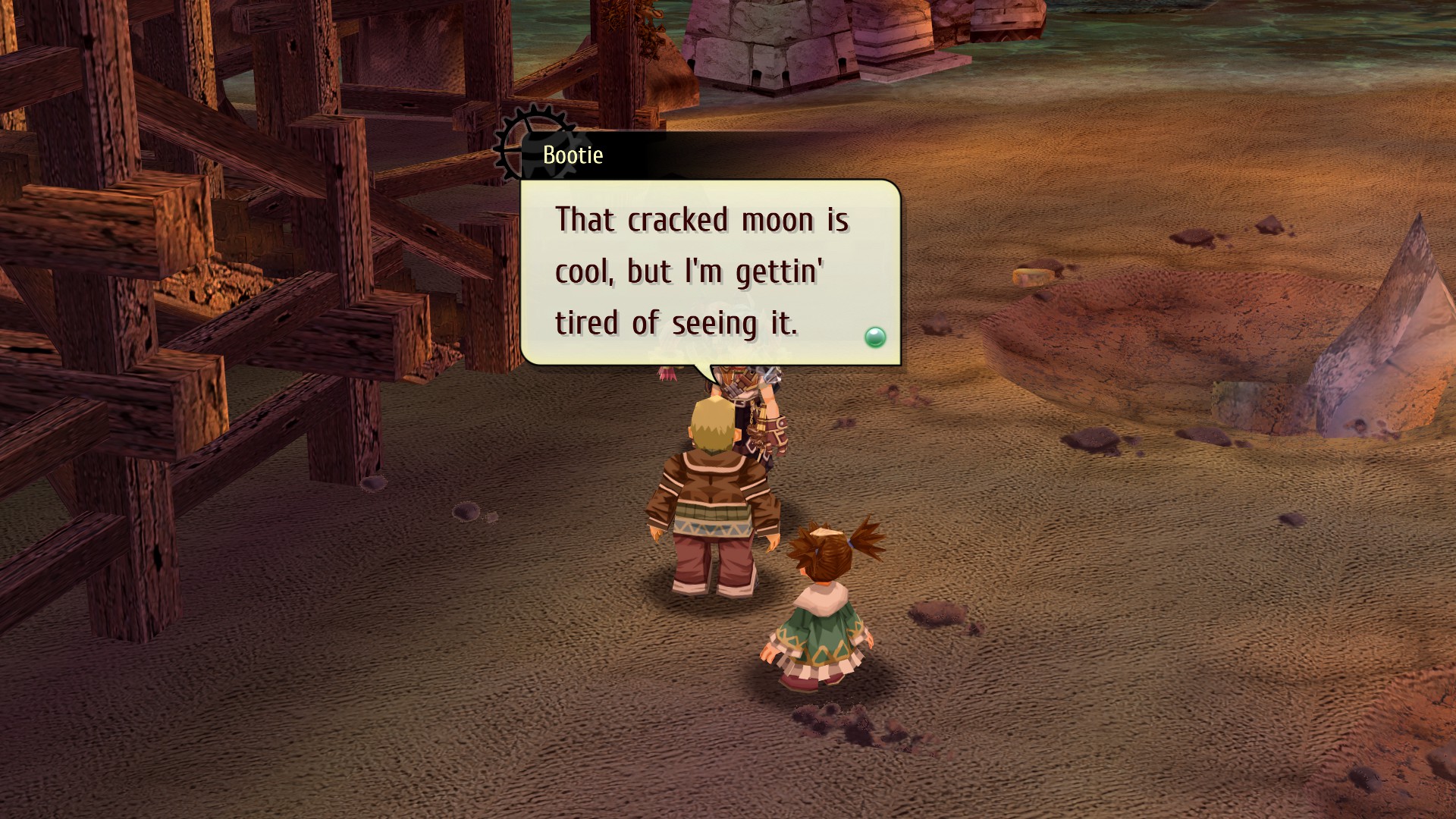
The Legend of Nayuta: Boundless Trails is not officially a Zwei game... but it shares so many traits with them that I seriously wonder if it was ever meant to be part of that series. Unfortunately, it comes nowhere close to reaching the same highs. I've got a review of Zwei: The Ilvard Insurrection and Zwei: The Arges Adventure, if you'd like to see my more detailed thoughts on those games.
This review is split up into a Story section and a Mechanics section. There are some gameplay and structure spoilers throughout, but the biggest story spoilers are blocked out. Also, for reference, I played Nayuta on Normal difficulty (out of Easy, Normal, and Hard). The Zwei games did not have difficulty options.
Story
My biggest issue with Nayuta is its story and writing. I can't remember a single time the game made me laugh on purpose. It is largely devoid of humor, unless you count "girl's confession always gets interrupted" or "boy can't see that girl obviously likes him" or "sleazy guard has the hots for all the village ladies" as humor. This alone is pretty damning, but unfortunately it also fails to write a single character I care about. Not even the cute fairy!! Okay I cared about Noi a little bit, but literally only because she's cute and a fairy.

Character moments fall flat and are about as unimaginative as it gets. As is often the case with Falcom games, there's a lot of dialogue to see by talking to everybody, two or three times each, every time the story advances at all. Where most of their other games use this to flesh out characters, subtly augment the stakes, give the immediate or larger world more flavor, or even just tell a joke... Nayuta instead retreads the same barren ground over and over. In fact, a majority of conversations kinda go on a few text boxes too many...
"Let's get to the tower now!"
"Yeah, we should hurry!"
"This will be our last stop before we can save her!"
"We can't miss our chance... I must save her!
"It's all or nothing now!"
"I just hope I'm strong enough..."
"Don't worry, Nayuta, we can do it together!"
"Noi..."
"I believe in us!"
"You're right. I believe in us, too!"
"Let's get going then!"
"Yeah, okay. Let's go!"
"Yeah!"
That kinda thing... To be fair, even the Falcom games I adore are guilty of this sometimes.
I wish I could stop talking about the story with that, but unfortunately there's more to say. If you don't mind some story spoilers, click below to see it. Otherwise, feel free to skip forward.
Click here for story spoilers
Every single dramatic event in the story is partially or wholly taken back by the end.
Village gets ravaged? It has no meaningful impact and is completely untarnished after a couple more story beats. Character gets deathly sick? They're completely fine after a quick side quest. Character dies? Actually for all these convoluted reasons, they didn't really die. Characters have a tearful final parting? Oh this convenient quirk in a machine lets them reunite and have a normal life together. Need to keep the existence of an ancient race secret from the villagers? They're actually entirely fine with it and hardly thought twice about it once they found out. Half the planet demolished by planetary collision? Don't worry, we fixed it with this crystal.
It all comes across as a contest between kids to come up with increasingly contrived reasons why they're invincible against this or that power, except it's earnest about all of it. While the main story beats were largely predictable, I was still baffled by how unwilling they were to commit to anything that wasn't a Happily-Ever-After... (firmly placing Nayuta in the Romance genre, it would seem.)
By the end of the After Story (more on that later), I had kind of lost the thread of convoluted logic and magic and coincidences that allowed all these dramatic events to be undone...
The plot can be summarized like so: "Humans are evil, so Earth should be destroyed and recreated. Actually, that would be sad. Instead, let's keep the status quo while casually thinking of a different plan as we go about our lives. Surely warring nations and humanity itself will realize they should not do war or environmental devastation."
Hm.
A quick note about the overall structure of the game: An "After Story" is unlocked at the end of the final chapter. It presents itself as a sort of post-game, but really it's more of an epilogue, and very long one at that! With all the stuff mentioned above, the game was already kinda dragging... but this After Story made it feel even worse. All the same problems in the main chapters were present here, and the worst of the stuff mentioned in the spoiler block above happens here. The 26hrs it took me to finish the game felt more like 60... (contrasting this to Final Fantasy X, which I've been playing in parallel, where the 26hrs I've played so far has felt more like 5!)
Okay, so the game isn't funny...
the characters are shallow...
the plot (spoilers)
undoes itself repeatedly...
and it's all a little too wordy...
Is the world at least interesting?

...Yes, actually! It's pretty inventive with its magical gears and machinery, star fragments holding visions of another world, administrator spirits watching over their continents, ancient ruins, season-based magic... It's an evocative and beautiful world! I wish it had leaned into some of this more though. The magic's ties to the seasons is pretty shallow, largely just an aesthetic thing, swapping your usual fire/water/wind/earth or whatever for spring/summer/autumn/winter.
The season stuff is put to its best use with the level design. Most of the game consists of 4 areas, each with a few levels within. You end up playing through each area in different seasons. Winter adds some slippery ice or thick snow to slow you down, summer brings lava tiles and quicksand, spring brings torrential rain and... poison? Autumn brings, uh... orange? Okay so it's not always that interesting of a change, but it at least will change up the visuals, enemies, and which paths are open or blocked off. The level's music gets a season-specific version too. It's all plenty to prevent staleness as you play the same 4 areas multiple times. You only play through 2 seasons per area in the main chapters, and a 3rd season per area in the After Story. I assume the 4th seasons becomes available in New Game+.
The main chapter levels were pretty good! They were generally pretty easy, but still enjoyable enough. The After Story levels are pretty meaty and I liked them quite a bit, although that enjoyment was dampened by how annoyed I was at the existence of the After Story itself. The bosses in the main chapters were mostly cool, but then you have to fight them again in the After Story "but they're harder this time!" ...except you're also way leveled up and have more gear and spells, so it really doesn't feel much different. It's not even a proper boss rush since you can freely go back to town to refresh between battles. You can do them in any order too, and the fights are bookended with "Alright we beat that one, but there's still more! Let's go to the next one!" type dialogue copied word-for-word between each fight. It made it completely narratively hollow (much like how Tears of the Kingdom suffers from a similar thing with its big boss fights).
Even though the After Story is effectively just another chapter, its "post-game" framing made it feel exhausting. I think it would have been better to incorporate its cool levels into the main game, skip the repeat boss fights, let the story continue from where the main chapters end, and finish off with the big fights and true story finale at the end of the After Story.

Mechanics
Okay, now for mechanics. This is where Nayuta feels most like a "Zwei 3". There are more similarities than I'll talk about here, but I'd say most of those are a less fun version of their Zwei counterpart. The things I talk about below are what I see as the most important comparisons. So let's look at some of what Nayuta inherits:
Combat
- Zwei Arges: Very basic but servicable. Near-instant character swapping. Melee and magic play very similarly. Probably the hardest combat of the 3 games due to how limited it is.
- Zwei Ilvard: More advanced via melee combos, spell variety, and special moves. Actually instant character swapping, and melee/magic have slightly more distinct play styles and use cases. All magic shares an ever-replenishing stamina bar, so you can't spam magic endlessly. This combat is still somewhat difficult, but you have more tools at your disposal.
- Nayuta: Even more melee combos, 2 melee weapon types (fast 1-hand and slow 2-hand), even more spell variety including status-inducing ones, and a couple special moves. No character swapping. You can use melee and magic effectively simultaneously, and their differences are quite distinct. You can have multiple spells equipped at once and swap between them on the fly. Each spell has its own stamina bar (or what is effectively a stamina bar), and killing enemies restores the currently-equipped spell faster. You can effectively use magic endlessly, or at least endlessly enough to eliminate immediate threats and have your spells ready to go again by the next encounter. Nayuta's combat is the most engaging and expressive of the 3 games, but also the easiest.
Rank (all of these let you get various useful rewards elsewhere)
- Zwei Arges & Ilvard: Get medals based on how well you did in the dungeon (time, damage taken, completion, etc). The focus is on learning the dungeons and executing precisely.
- Nayuta: 3 stars available per dungeon. 1 for clearing the dungeon, 1 if you find all the secrets, and 1 if you fulfill a unique clear condition (defeat at least 20 enemies, jump less than 10 times, etc). The focus is more on playing a specific way than on learning the layout or executing well. I often got all 3 stars without really trying.
Food, healing, EXP
- Zwei Arges & Ilvard: Enemies/chests sometimes drop food. Eating food is the only way to gain EXP, but also the only way to heal mid-dungeon. Exchange 10 of 1 food to get 1 of a better food. Food shares a finite inventory with your gear and all other items.
- Nayuta: Enemies and shops drop ingredients, and your inventory has unlimited capacity. No food exchange. Instead, ingredients are inedible but can be turned into food outside of dungeons via recipes. More recipes are gradually unlocked. When you make food, you can eat it immediately (for EXP) or store it in 1 of a few lunchboxes for use inside a dungeon (for healing and EXP). Also, crucially... food is not the only way you can heal or get EXP. Killing monsters gives EXP, and some breakable objects within dungeons drop healing items (you can even equip gear to increase EXP gain or make healing items appear more often).
I wanna focus in more on that last point about food. A large part of what makes the dungeon crawling of the Zwei games so compelling is that you have to seriously consider if you should eat food immediately for a quick restore, or save it to exchange for something better after you clear the level. This is a delicious tension underpinning every dungeon (especially in Zwei Arges, where teleporting in/out requires a consumable!). It's super satisfying to barely scrape through a dungeon and then turn in all your cheeseburgers for a durian or whatever. It also requires a bit of planning to keep certain foods in reserve for tough boss fights. This tension is compeltely absent in Nayuta. I rarely felt the need to eat food for EXP since I levelled up at a decent pace from regular play. I even more rarely ate food for healing since the game was pretty easy, dungeons were shorter, and healing pickups would usually appear whenever my health was low. Even if the game were harder though, the tension would be "I hope I can get by with the limited food I already made" rather than the more interesting "I hope I can get by without wasting too much of the food I need to level up."
So despite Nayuta having the most fun combat of the 3 games, it's deflated by the lack of any real tension in the systems surrounding it. After my complaints about the writing, this is my biggest issue with the game.
The trails are actually quite bounded
*sighhhhh* Well, The Legend of Nayuta: Boundless Trails is the first Falcom game that has thoroughly disappointed me. They can't all be bangers, I suppose, but I'm still puzzled by some of their decisions. This is pure speculation on my part, but it feels like this game was actually "Zwei 3" at one point, but was transplanted mid-development into a more Trails-like thing. Of the Trails series I've only played Sky FC and SC, so I can't comment on if/how it's connected to the larger Trails series. A little bit of research implies there's basically no real connection, but who knows. From my perspective, all it accomplished was replacing the Saturday morning cartoon vibe of the Zwei games with something much more self-serious without the care put into the writing to make it work.
While I can't really recommend Nayuta, it does stil have enjoyable parts, and the fairy is indeed Very Cute (though she never did beat the snot out of the protagonist like Rue in Zwei Ilvard did :c ). I think it's possible to enjoy this game as a straightforward action dungeon crawler as long as you plug your ears during the story segments (and maybe play on Hard).
I'll recommend the Zwei games forever, though
